Electrochemical Detection of Bisphenol S Based on Molecularly Imprinted Polymers Grafted on Functionalized Multiwalled Carbon Nanotubes: A Facile Sensor Fabrication Approach
Abstract
1. Introduction
2. Materials and Methods
2.1. Reagents
2.2. Instruments
2.3. Vinyl Functionalization of MWCNTs
2.4. Synthesis of MIP@f-MWCNTs Nanocomposites
2.5. Electrode Modification and Electrochemical Measurements
2.6. Quantification of BPS in Real Samples
3. Results and Discussion
3.1. Characterization of Fabricated Materials
3.1.1. FT-IR of Synthesized Materials
3.1.2. Morphological Characterization
3.2. Electrochemical Characteristics of Differently Modified GCEs and Response to BPS
3.3. Optimization of the Electrochemical Protocol
3.3.1. Effect of pH and Incubation Time on the Response of the Electrode
3.3.2. Effect of Scan Rate
3.4. Analytical Performance: The Analytical Curve and Limit of Detection
3.5. Selectivity and Interference Studies
3.6. Repeatability, Reproducibility, and Stability of the Fabricated Sensor
3.7. Analytical Applications of the Sensor in Real Samples
4. Conclusions
Supplementary Materials
Author Contributions
Funding
Institutional Review Board Statement
Informed Consent Statement
Data Availability Statement
Conflicts of Interest
References
- Hamed, E.M.; Li, S.F.Y. Molecularly imprinted polymers-based sensors for bisphenol-A: Recent developments and applications in environmental, food and biomedical analysis. Trends Environ. Anal. Chem. 2022, 35, e00167. [Google Scholar] [CrossRef]
- Guida, M.; Troisi, J.; Ciccone, C.; Granozio, G.; Cosimato, C.; Sardo, A.D.S.; Ferrara, C.; Guida, M.; Nappi, C.; Zullo, F.; et al. Bisphenol A and congenital developmental defects in humans. Mutat. Res. 2015, 774, 33–39. (In English) [Google Scholar] [CrossRef] [PubMed]
- Pérez-Bermejo, M.; Mas-Pérez, I.; Murillo-Llorente, M.T. The Role of the Bisphenol A in Diabetes and Obesity. Biomedicines 2021, 9, 666. (In English) [Google Scholar] [CrossRef] [PubMed]
- Stillwater, B.J.; Bull, A.C.; Romagnolo, D.F.; Neumayer, L.A.; Donovan, M.G.; Selmin, O.I. Bisphenols and Risk of Breast Cancer: A Narrative Review of the Impact of Diet and Bioactive Food Components. Front. Nutr. 2020, 7, 581388. (In English) [Google Scholar] [CrossRef] [PubMed]
- Canada, G.O. Order amending schedule I to the hazardous products act (Bisphenol A). Can. Gaz. Part II 2010, 144, 413–426. [Google Scholar]
- Cheng, R.; Ding, Y.; Wang, Y.; Wang, H.; Zhang, Y.; Wei, Q. A novel molecularly imprinted electrochemiluminescence sensor based on cobalt nitride nanoarray electrode for the sensitive detection of bisphenol S. RSC Adv. 2021, 11, 11011–11019. [Google Scholar] [CrossRef]
- Wu, L.H.; Zhang, X.-M.; Wang, F.; Gao, C.-J.; Chen, D.; Palumbo, J.R.; Guo, Y.; Zeng, E.Y. Occurrence of bisphenol S in the environment and implications for human exposure: A short review. Sci. Total Environ. 2018, 615, 87–98. [Google Scholar] [CrossRef]
- Rahman, S.; Bozal-Palabiyik, B.; Unal, D.N.; Erkmen, C.; Siddiq, M.; Shah, A.; Uslu, B. Molecularly imprinted polymers (MIPs) combined with nanomaterials as electrochemical sensing applications for environmental pollutants. Trends Environ. Anal. Chem. 2022, 36, e00176. [Google Scholar] [CrossRef]
- Gan, T.; Sun, J.; Meng, W.; Song, L.; Zhang, Y. Electrochemical sensor based on graphene and mesoporous TiO2 for the simultaneous determination of trace colourants in food. Food Chem. 2013, 141, 3731–3737. [Google Scholar] [CrossRef]
- Pang, Y.-H.; Huang, Y.-Y.; Wang, L.; Shen, X.-F.; Wang, Y.-Y. Determination of bisphenol A and bisphenol S by a covalent organic framework electrochemical sensor. Environ. Pollut. 2020, 263, 114616. [Google Scholar] [CrossRef]
- Zahedi, P.; Ziaee, M.; Abdouss, M.; Farazin, A.; Mizaikoff, B. Biomacromolecule template-based molecularly imprinted polymers with an emphasis on their synthesis strategies: A review. Polym. Adv. Technol. 2016, 27, 1124–1142. [Google Scholar] [CrossRef]
- Anirudhan, T.S.; Athira, V.S.; Sekhar, V.C. Electrochemical sensing and nano molar level detection of Bisphenol-A with molecularly imprinted polymer tailored on multiwalled carbon nanotubes. Polymer 2018, 146, 312–320. [Google Scholar] [CrossRef]
- Rao, H.; Chen, M.; Ge, H.; Lu, Z.; Liu, X.; Zou, P.; Wang, X.; He, H.; Zeng, X.; Wang, Y. A novel electrochemical sensor based on Au@ PANI composites film modified glassy carbon electrode binding molecular imprinting technique for the determination of melamine. Biosens. Bioelectron. 2017, 87, 1029–1035. [Google Scholar] [CrossRef]
- Mohanan, V.M.A.; Kunnummal, A.K.; Biju, V.M.N. Selective electrochemical detection of dopamine based on molecularly imprinted poly (5-amino 8-hydroxy quinoline) immobilized reduced graphene oxide. J. Mater. Sci. 2018, 53, 10627–10639. [Google Scholar] [CrossRef]
- Ertürk, G.; Mattiasson, B. Molecular Imprinting Techniques Used for the Preparation of Biosensors. Sensors 2017, 17, 288. [Google Scholar] [CrossRef] [PubMed]
- Kadhem, A.J.; Gentile, G.J.; de Cortalezzi, M.M.F. Molecularly Imprinted Polymers (MIPs) in Sensors for Environmental and Biomedical Applications: A Review. Molecules 2021, 26, 6233. [Google Scholar] [CrossRef]
- Lavagna, L.; Bartoli, M.; Suarez-Riera, D.; Cagliero, D.; Musso, S.; Pavese, M. Oxidation of Carbon Nanotubes for Improving the Mechanical and Electrical Properties of Oil-Well Cement-Based Composites. ACS Appl. Nano Mater. 2022, 5, 6671–6678. [Google Scholar] [CrossRef]
- Zhang, X.-L.; Zhang, Y.; Yin, X.-F.; Du, B.-B.; Zheng, C.; Yang, H.-H. A facile approach for preparation of molecularly imprinted polymers layer on the surface of carbon nanotubes. Talanta 2013, 105, 403–408. [Google Scholar] [CrossRef]
- Qazi, R.A.; Khattak, R.; Shah, L.A.; Ullah, R.; Khan, M.S.; Sadiq, M.; Hessien, M.M.; El-Bahy, Z.M. Effect of MWCNTs Functionalization on Thermal, Electrical, and Ammonia-Sensing Properties of MWCNTs/PMMA and PHB/MWCNTs/PMMA Thin Films Nanocomposites. Nanomaterials 2021, 11, 2625. (In English) [Google Scholar] [CrossRef]
- Meng, X.; Xiao, Z.; Scott, S.K. Preparation and Application of Electrochemical Sensor Based on Molecularly Imprinted Polymer Coated Multi-Walled Carbon Nanotubes for Nitrocellulose Detection. Propellants Explos. Pyrotech. 2019, 44, 1337–1346. [Google Scholar] [CrossRef]
- Rosca, I.D.; Watari, F.; Uo, M.; Akasaka, T. Oxidation of multiwalled carbon nanotubes by nitric acid. Carbon 2005, 43, 3124–3131. [Google Scholar] [CrossRef]
- Chowdhry, A.; Kaur, J.; Khatri, M.; Puri, V.; Tuli, R.; Puri, S. Characterization of functionalized multiwalled carbon nanotubes and comparison of their cellular toxicity between HEK 293 cells and zebra fish in vivo. Heliyon 2019, 5, e02605. (In English) [Google Scholar] [CrossRef]
- Hole, R.; Munde, A.; Jaybhaye, S. Functionalization of multiwalled carbon nanotubes with active pharmaceutical ingredient via carboxylation. Mater. Today Proc. 2021, 45, 3860–3862. [Google Scholar] [CrossRef]
- Sharipov, M.; Ju, T.J.; Azizov, S.; Turaev, A.; Lee, Y.-I. Novel molecularly imprinted nanogel modified microfluidic paper-based SERS substrate for simultaneous detection of bisphenol A and bisphenol S traces in plastics. J. Hazard. Mater. 2024, 461, 132561. [Google Scholar] [CrossRef]
- Sharma, B.; Frontiera, R.R.; Henry, A.-I.; Ringe, E.; Van Duyne, R.P. SERS: Materials, applications, and the future. Mater. Today 2012, 15, 16–25. [Google Scholar] [CrossRef]
- Shanmugasundaram, K.B.; Li, J.; Sina, A.I.; Wuethrich, A.; Trau, M. Toward precision oncology: SERS microfluidic systems for multiplex biomarker analysis in liquid biopsy. Mater. Adv. 2022, 3, 1459–1471. [Google Scholar] [CrossRef]
- Hyder, A.; Ali, A.; Buledi, J.A.; Memon, R.; Al-Anzi, B.S.; Memon, A.A.; Kazi, M.; Solangi, A.R.; Yang, J.; Thebo, K.H. A NiO-nanostructure-based electrochemical sensor functionalized with supramolecular structures for the ultra-sensitive detection of the endocrine disruptor bisphenol S in an aquatic environment. Phys. Chem. Chem. Phys. 2024, 26, 10940–10950. [Google Scholar] [CrossRef] [PubMed]
- Rao, H.; Zhao, X.; Liu, X.; Zhong, J.; Zhang, Z.; Zou, P.; Jiang, Y.; Wang, X.; Wang, Y. A novel molecularly imprinted electrochemical sensor based on graphene quantum dots coated on hollow nickel nanospheres with high sensitivity and selectivity for the rapid determination of bisphenol S. Biosens. Bioelectron. 2018, 100, 341–347. (In English) [Google Scholar] [CrossRef]
- Ansari, S.A. Graphene Quantum Dots: Novel Properties and Their Applications for Energy Storage Devices. Nanomaterials 2022, 12, 3814. (In English) [Google Scholar] [CrossRef]
- Sreelakshmi, T.R.; Sajini, T.; Mathew, B. Fabrication of Vinyl Functionalised Multiwalled Carbon Nanotubes for the Removal of Organic Pollutant. Adv. Mater. Res. 2023, 1175, 63–72. [Google Scholar] [CrossRef]
- Gorla, F.A.; Ferreira, M.D.P.; Santos, C.S.D.; de Matos, R.; Segatelli, M.G.; Tarley, C.R.T. Highly sensitive and selective dopamine determination using a photoelectrochemical sensor based on the BiVO4 and surface molecularly imprinted poly(acrylic acid-co-TRIM) on vinyl functionalized carbon nanotubes. J. Electroanal. Chem. 2024, 953, 117988. [Google Scholar] [CrossRef]
- Kan, X.; Zhao, Y.; Geng, Z.; Wang, Z.; Zhu, J.-J. Composites of Multiwalled Carbon Nanotubes and Molecularly Imprinted Polymers for Dopamine Recognition. J. Phys. Chem. C 2008, 112, 4849–4854. [Google Scholar] [CrossRef]
- Anirudhan, T.S.; Alexander, S. Synthesis and characterization of vinyl-functionalized multiwalled carbon nanotubes based molecular imprinted polymer for the separation of chlorpyrifos from aqueous solutions. J. Chem. Technol. Biotechnol. 2013, 88, 1847–1858. [Google Scholar] [CrossRef]
- Zhao, Z.; Yang, Z.; Hu, Y.; Li, J.; Fan, X. Multiple functionalization of multi-walled carbon nanotubes with carboxyl and amino groups. Appl. Surf. Sci. 2013, 276, 476–481. [Google Scholar] [CrossRef]
- Du, J.; Gao, R.; Mu, H. A Novel Molecularly Imprinted Polymer Based on Carbon Nanotubes for Selective Determination of Dioctyl Phthalate from Beverage Samples Coupled with GC/MS. Food Anal. Methods 2016, 9, 2026–2035. [Google Scholar] [CrossRef]
- Gao, R.; Su, X.; He, X.; Chen, L.; Zhang, Y. Preparation and characterisation of core–shell CNTs@MIPs nanocomposites and selective removal of estrone from water samples. Talanta 2011, 83, 757–764. [Google Scholar] [CrossRef] [PubMed]
- Atieh, M.A.; Bakather, O.Y.; Al-Tawbini, B.; Bukhari, A.A.; Abuilaiwi, F.A.; Fettouhi, M.B.; Butler, I. Effect of carboxylic functional group functionalized on carbon nanotubes surface on the removal of lead from water. Bioinorg. Chem. Appl. 2010, 2010, 603978. (In English) [Google Scholar] [CrossRef]
- da Silva, N.A.; Haiduke, R.L.A. Infrared intensity analysis of hydroxyl stretching modes in carboxylic acid dimers by means of the charge–charge flux–dipole flux model. J. Comput. Chem. 2019, 40, 2482–2490. [Google Scholar] [CrossRef]
- Abdelkader, R.; Mohammed, B. Green Synthesis of Cationic Polyacrylamide Composite Catalyzed by An Ecologically Catalyst Clay Called Maghnite-H+ (Algerian MMT) Under Microwave Irradiation. Bull. Chem. React. Eng. Catal. 2016, 11, 170–175. [Google Scholar] [CrossRef]
- Singh, B.P.; Choudhary, V.; Teotia, S.; Gupta, T.K.; Singh, V.N.; Dhakate, S.R.; Mathur, R.B. Solvent Free, Efficient, Industrially Viable, Fast Dispersion Process Based Amine Modified MWCNT Reinforced Epoxy Composites Of Superior Mechanical Properties. Adv. Mater. Lett. 2015, 6, 104–113. [Google Scholar] [CrossRef]
- Tsague, L.F.; Ejuh, G.; Ngoupo, A.T.; Assatse, Y.T.; Kamsi, R.Y.; Abe, M.O.; Ndjaka, J. Ab-initio and density functional theory (DFT) computational study of the effect of fluorine on the electronic, optical, thermodynamic, hole and electron transport properties of the circumanthracene molecule. Heliyon 2023, 9, e19647. [Google Scholar] [CrossRef] [PubMed]
- Roushani, M.; Zalpour, N. Selective detection of Asulam with in-situ dopamine electropolymerization based electrochemical MIP sensor. React. Funct. Polym. 2021, 169, 105069. [Google Scholar] [CrossRef]
- Song, C.; Yang, Y.; Zhou, Y.; Wang, L.; Zhu, S.; Wang, J.; Zeng, R.; Zheng, Y.; Guan, S. Electrochemical polymerization of dopamine with/without subsequent PLLA coating on Mg-Zn-Y-Nd alloy. Mater. Lett. 2019, 252, 202–206. [Google Scholar] [CrossRef]
- Jin, Y.-F.; Zhang, Y.-J.; Zhang, Y.-P.; Chen, J.; Zhou, X.-M.; Bai, L.-Y.; Curcio, M. Synthesis and evaluation of molecularly imprinted polymer for the determination of the phthalate esters in the bottled beverages by HPLC. J. Chem. 2013, 2013, 903210. [Google Scholar] [CrossRef]
- Caetano, F.R.; Felippe, L.B.; Zarbin, A.J.; Bergamini, M.F.; Marcolino-Junior, L.H. Gold nanoparticles supported on multi-walled carbon nanotubes produced by biphasic modified method and dopamine sensing application. Sens. Actuators B Chem. 2017, 243, 43–50. [Google Scholar] [CrossRef]
- Ye, Z.; Wang, Q.; Qiao, J.; Ye, B.; Li, G. Simultaneous detection of bisphenol A and bisphenol S with high sensitivity based on a new electrochemical sensor. J. Electroanal. Chem. 2019, 854, 113541. [Google Scholar] [CrossRef]
- Wu, L.; Lin, Y.; Zhang, Y.; Wang, P.; Ding, M.; Nie, M.; Yan, C.; Chen, S. Ca(OH)2-mediated activation of peroxymonosulfate for the degradation of bisphenol S. RSC Adv. 2021, 11, 33626–33636. [Google Scholar] [CrossRef]
- Elgrishi, N.; Rountree, K.J.; McCarthy, B.D.; Rountree, E.S.; Eisenhart, T.T.; Dempsey, J.L. A practical beginner’s guide to cyclic voltammetry. J. Chem. Educ. 2018, 95, 197–206. [Google Scholar] [CrossRef]
- Çakıcı, M.; Avan, A.A.; Filik, H.; Yetimoğlu, E.K. Individual and Simultaneous Electrochemical Detection of Bisphenol A and Bisphenol S in Food Samples Using Triethylenetetramine Functionalized Multi-Walled Carbon Nanotubes. Food Anal. Methods 2023, 16, 225–237. [Google Scholar] [CrossRef]
- Wang, X.; Li, M.; Wu, M.; Shi, Y.; Yang, J.; Shan, J.; Liu, L. Simultaneous Determination of Bisphenol A and Bisphenol S Using Multi-Walled Carbon Nanotubes Modified Electrode. Int. J. Electrochem. Sci. 2018, 13, 11906–11922. [Google Scholar] [CrossRef]
- Zheng, Z.; Liu, J.; Wang, M.; Cao, J.; Li, L.; Wang, C.; Feng, N. Selective sensing of bisphenol A and bisphenol S on platinum/poly (diallyl dimethyl ammonium chloride)-diamond powder hybrid modified glassy carbon electrode. J. Electrochem. Soc. 2016, 163, B192. [Google Scholar] [CrossRef]
- Zhu, W.; Yue, X.; Duan, J.; Zhang, Y.; Zhang, W.; Yu, S.; Wang, Y.; Zhang, D.; Wang, J. Electrochemically co-reduced 3D GO-C60 nanoassembly as an efficient nanocatalyst for electrochemical detection of bisphenol S. Electrochim. Acta 2016, 188, 85–90. [Google Scholar] [CrossRef]
- Huang, Y.-Y.; Pang, Y.-H.; Shen, X.-F.; Jiang, R.; Wang, Y.-Y. Covalent organic framework DQTP modified pencil graphite electrode for simultaneous determination of bisphenol A and bisphenol S. Talanta 2022, 236, 122859. [Google Scholar] [CrossRef] [PubMed]
- Wang, Q.; Zhang, D.; Yang, L.; Zhang, L. Constructed ILs@ hollow porous spherical Ni-loaded CdFe2O4 modified electrode for highly sensitive simultaneous electrochemical analysis of bisphenols. Sens. Actuators B Chem. 2017, 246, 800–808. [Google Scholar] [CrossRef]
- Prueitt, R.L.; Goodman, J.E. Evidence evaluated by European Food Safety Authority does not support lowering the temporary tolerable daily intake for bisphenol A. Toxicol. Sci. 2024, 198, 185–190. (In English) [Google Scholar] [CrossRef]
- Vom Saal, F.S.; Antoniou, M.; Belcher, S.M.; Bergman, A.; Bhandari, R.K.; Birnbaum, L.S.; Cohen, A.; Collins, T.J.; Demeneix, B.; Fine, A.M.; et al. The Conflict between Regulatory Agencies over the 20,000-Fold Lowering of the Tolerable Daily Intake (TDI) for Bisphenol A (BPA) by the European Food Safety Authority (EFSA). Environ. Health Perspect. 2024, 132, 45001. (In English) [Google Scholar] [CrossRef]
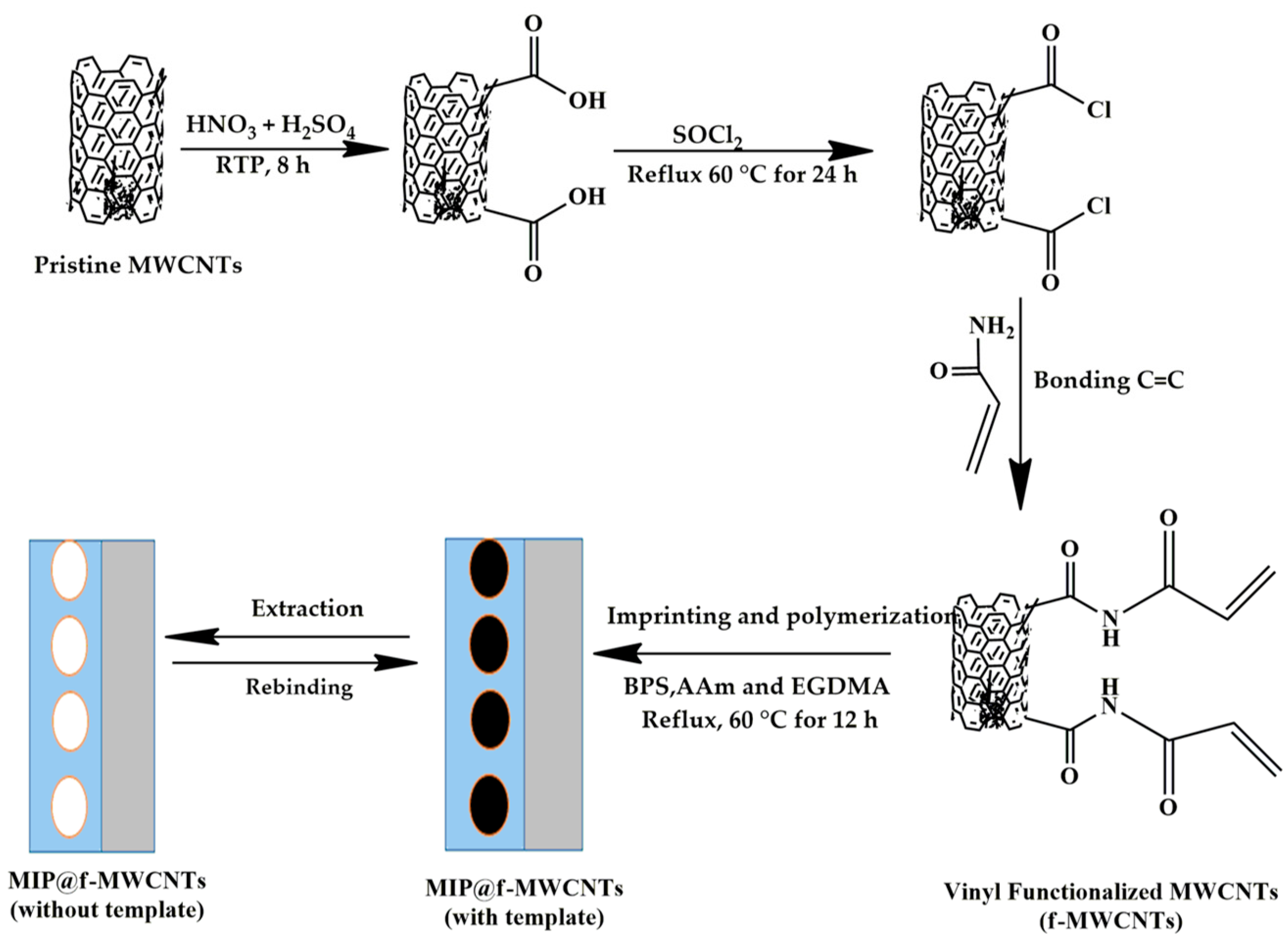
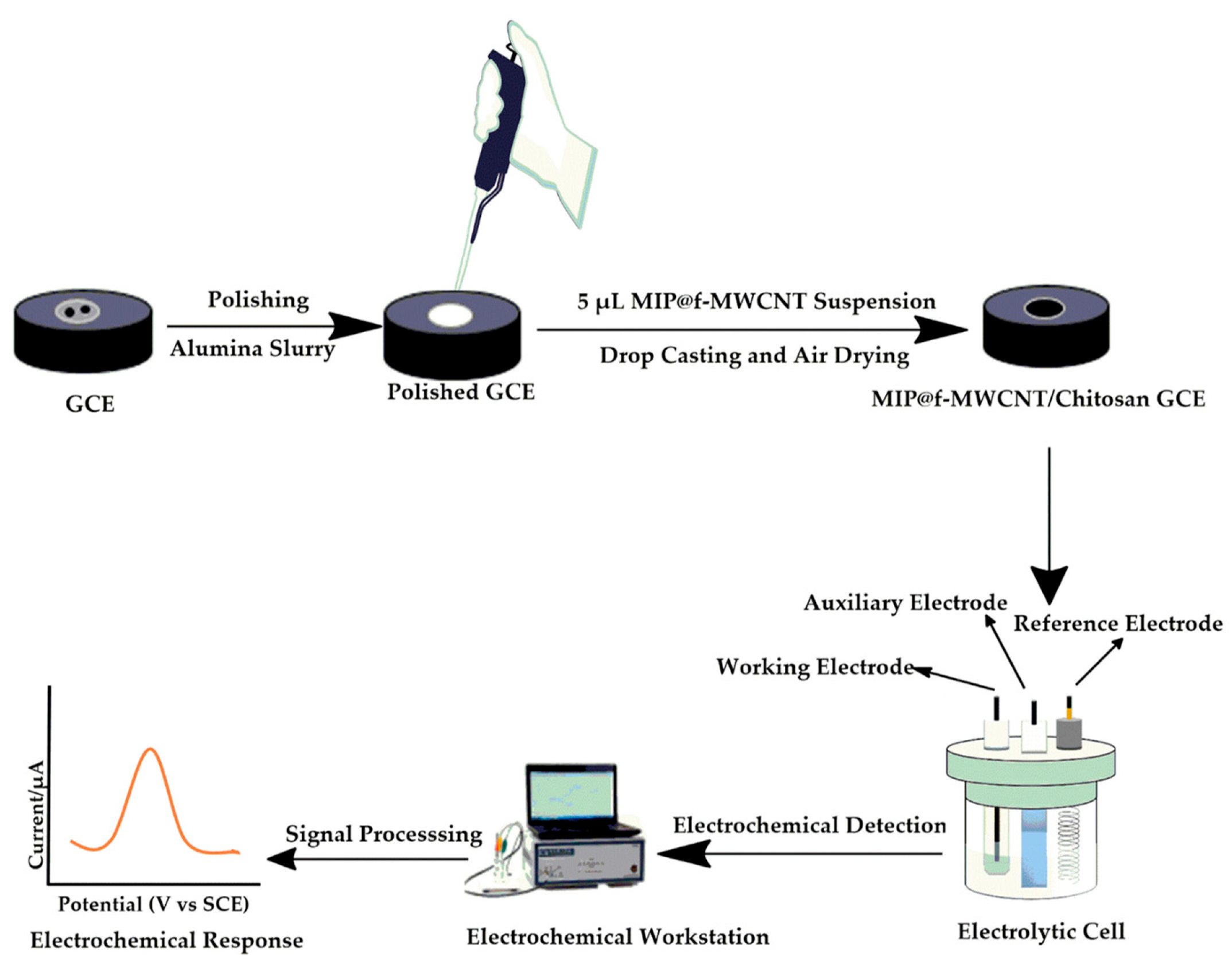
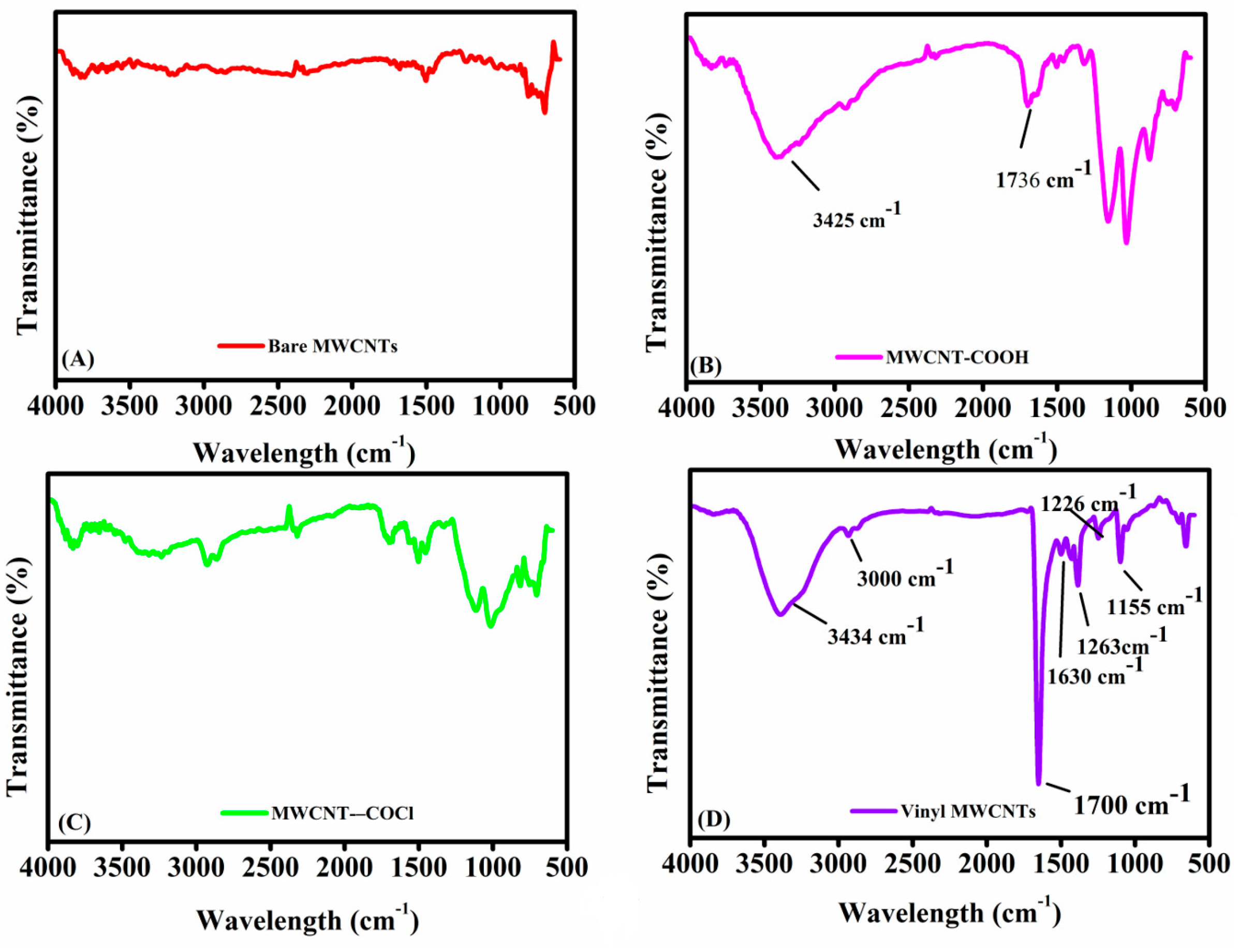
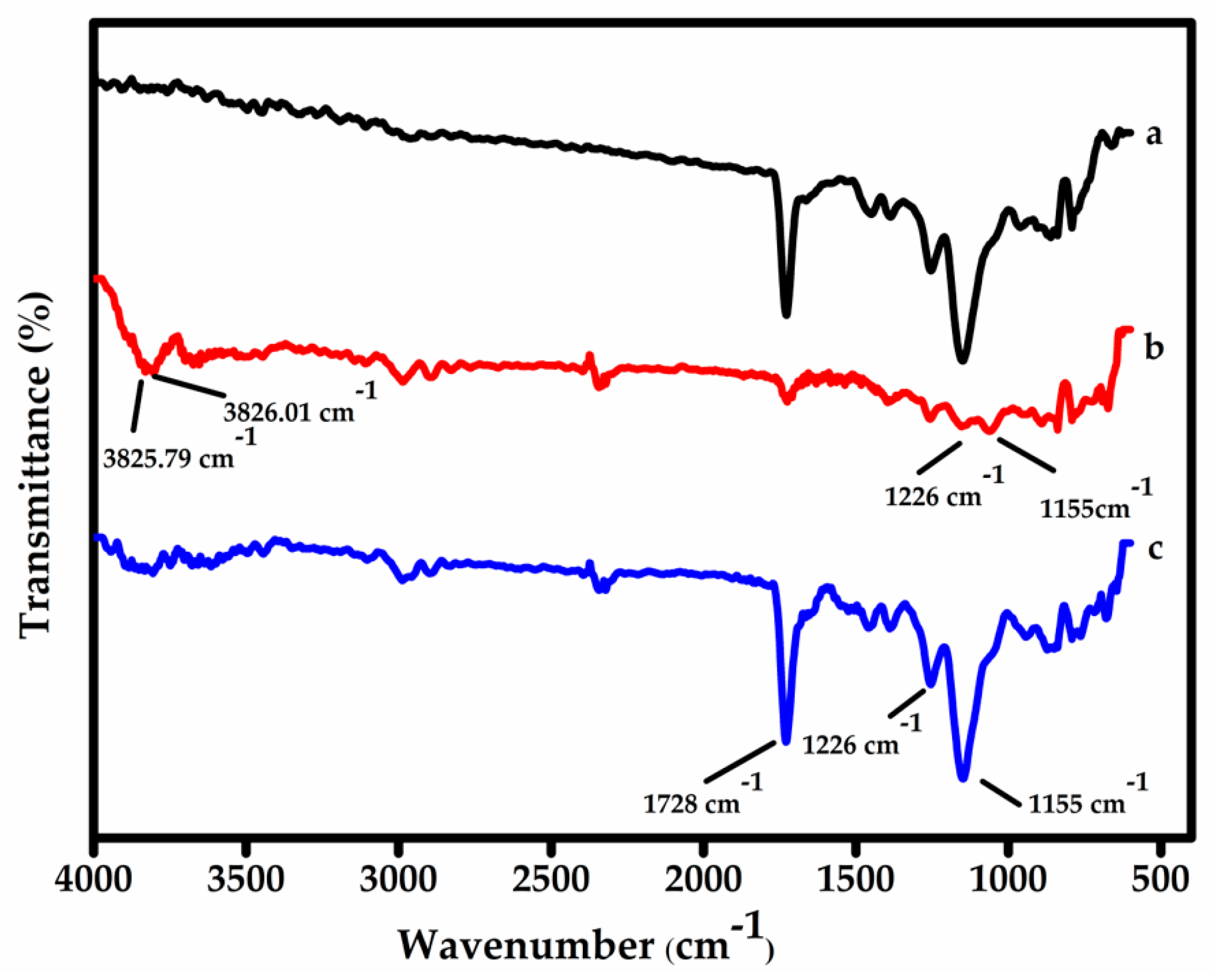


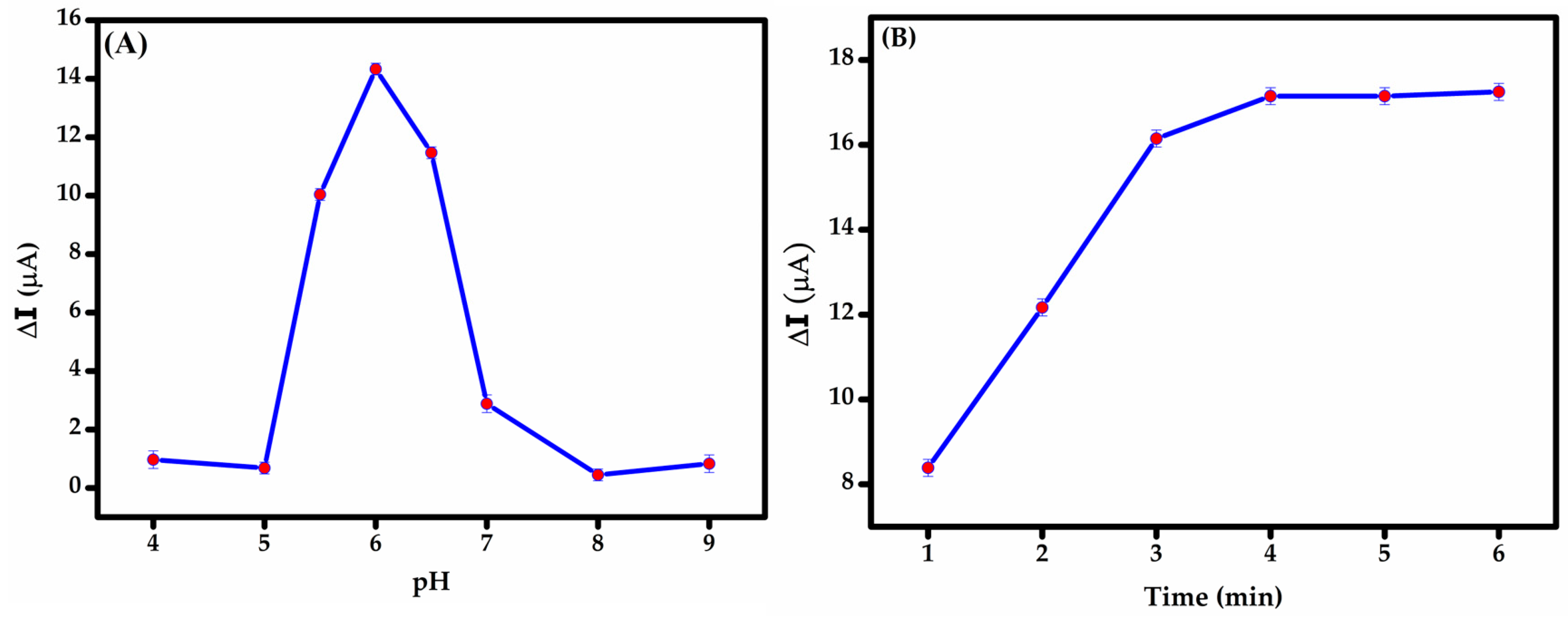
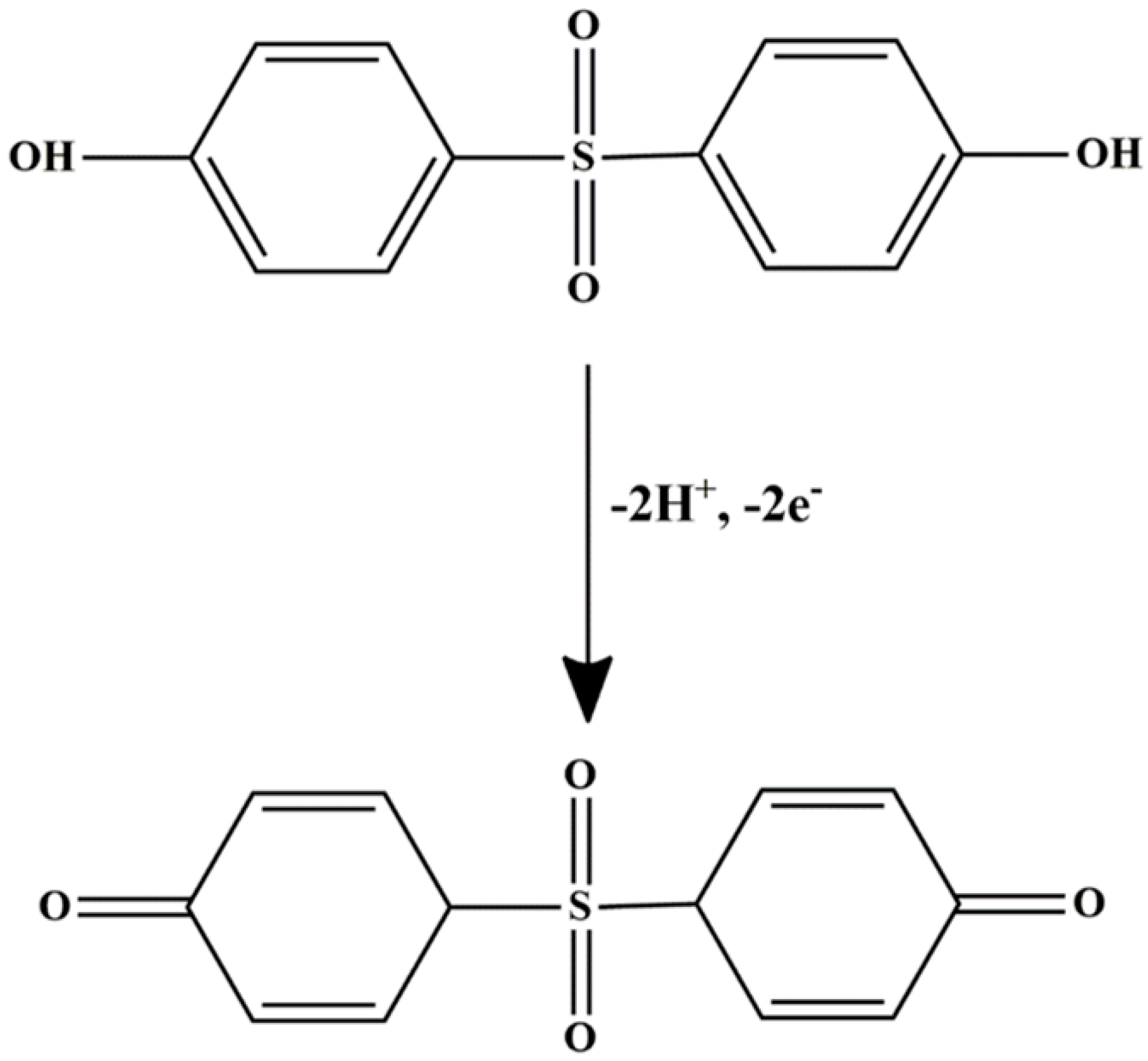

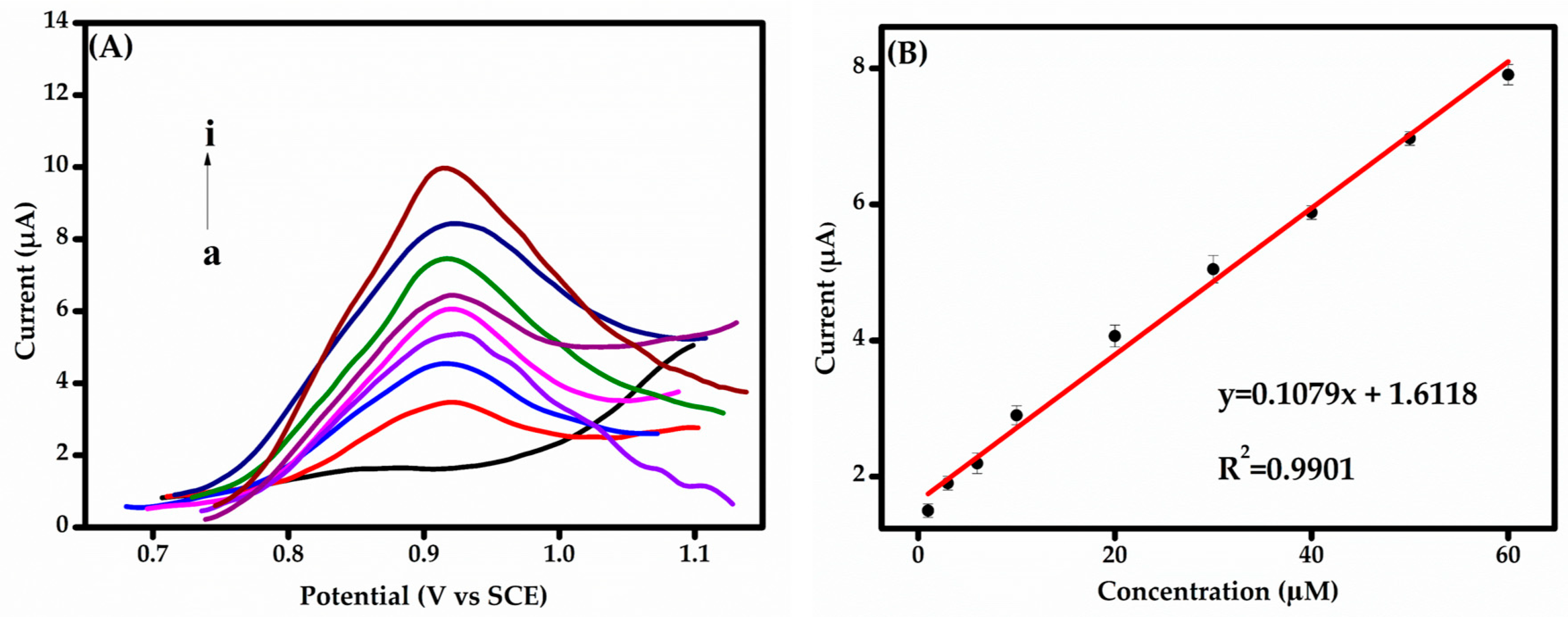
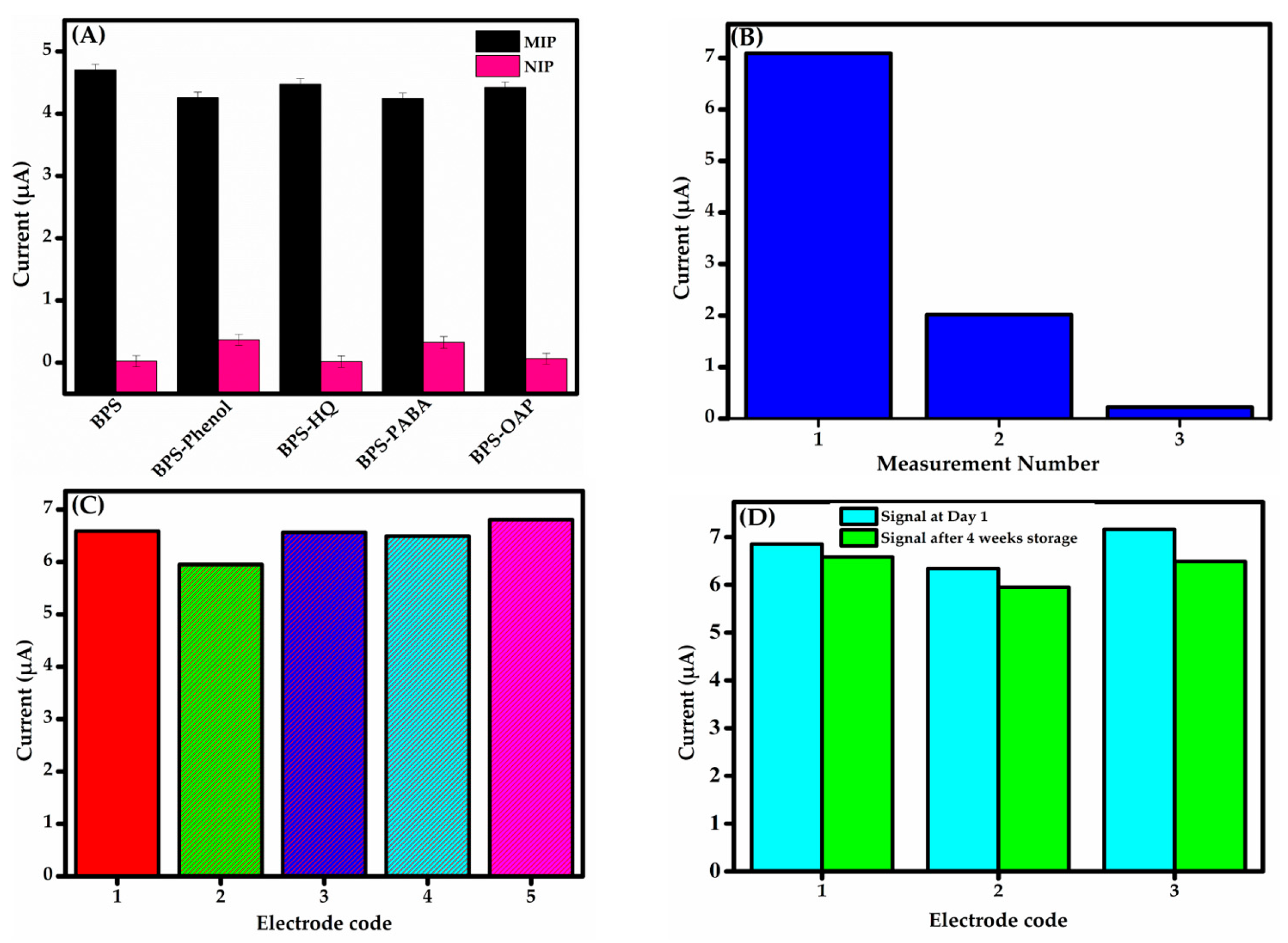
| Sensor Architecture | LoD (µM) | Sensitivity (μA⋅μM−1) | Linear Range (µM) | Ref. |
|---|---|---|---|---|
| AuAgPtPCD-GO | 0.0027 | 0.972 | 1–8 | [46] |
| hNiNS/GQDs/MIPs | 0.03 | 0.217 | 0.1–50 | [28] |
| MWCNTs | 4.0 | 0.188 | 2.0–80 | [50] |
| TETA-MWCNTs | 0.56 | 0.745 | 1.0–30 | [49] |
| Pt/PDDA-DMP | 2.0 | 0.010 | 10–60 | [51] |
| COF CTpPa-2/GCE | 0.09 | −0.050 | 0.5–50 | [10] |
| Electrochemically co-reduced 3-D GO-C60 nano-assembly | 0.5 | 0.685 | 1–100 | [52] |
| Platinum/poly(diallyl dimethyl ammonium chloride)-diamond powder hybrid | 2.0 | 10.42 | 10–60 | [51] |
| COF-DQTP modified PGE | 0.15 | −0.139 | 0.5–30 | [53] |
| ILs@HPS-Ni/CdFe2O4/GCE | 0.00537 | 0.041 | 0.008–0.160 | [54] |
| MIP@MWCNTs/GCE | 2.00 | 0.108 | 1–60 | This work |
| Sample | Added (μM) | Found (μM) | RSD (%) | Recovery (%) |
|---|---|---|---|---|
| Plastic bottle water extract | 12.5 | 13.1 (±0.17) | 5.50 | 105.0 |
| 30 | 30.4 (±0.39) | 7.93 | 101.6 | |
| 50 | 48.0 (±0.49) | 7.23 | 95.9 |
Disclaimer/Publisher’s Note: The statements, opinions and data contained in all publications are solely those of the individual author(s) and contributor(s) and not of MDPI and/or the editor(s). MDPI and/or the editor(s) disclaim responsibility for any injury to people or property resulting from any ideas, methods, instructions or products referred to in the content. |
© 2025 by the authors. Licensee MDPI, Basel, Switzerland. This article is an open access article distributed under the terms and conditions of the Creative Commons Attribution (CC BY) license (https://creativecommons.org/licenses/by/4.0/).
Share and Cite
Mwanza, C.; Zhao, L.; Zhang, Q.; Ding, S.-N. Electrochemical Detection of Bisphenol S Based on Molecularly Imprinted Polymers Grafted on Functionalized Multiwalled Carbon Nanotubes: A Facile Sensor Fabrication Approach. Chemosensors 2025, 13, 236. https://doi.org/10.3390/chemosensors13070236
Mwanza C, Zhao L, Zhang Q, Ding S-N. Electrochemical Detection of Bisphenol S Based on Molecularly Imprinted Polymers Grafted on Functionalized Multiwalled Carbon Nanotubes: A Facile Sensor Fabrication Approach. Chemosensors. 2025; 13(7):236. https://doi.org/10.3390/chemosensors13070236
Chicago/Turabian StyleMwanza, Christopher, Lin Zhao, Qing Zhang, and Shou-Nian Ding. 2025. "Electrochemical Detection of Bisphenol S Based on Molecularly Imprinted Polymers Grafted on Functionalized Multiwalled Carbon Nanotubes: A Facile Sensor Fabrication Approach" Chemosensors 13, no. 7: 236. https://doi.org/10.3390/chemosensors13070236
APA StyleMwanza, C., Zhao, L., Zhang, Q., & Ding, S.-N. (2025). Electrochemical Detection of Bisphenol S Based on Molecularly Imprinted Polymers Grafted on Functionalized Multiwalled Carbon Nanotubes: A Facile Sensor Fabrication Approach. Chemosensors, 13(7), 236. https://doi.org/10.3390/chemosensors13070236







